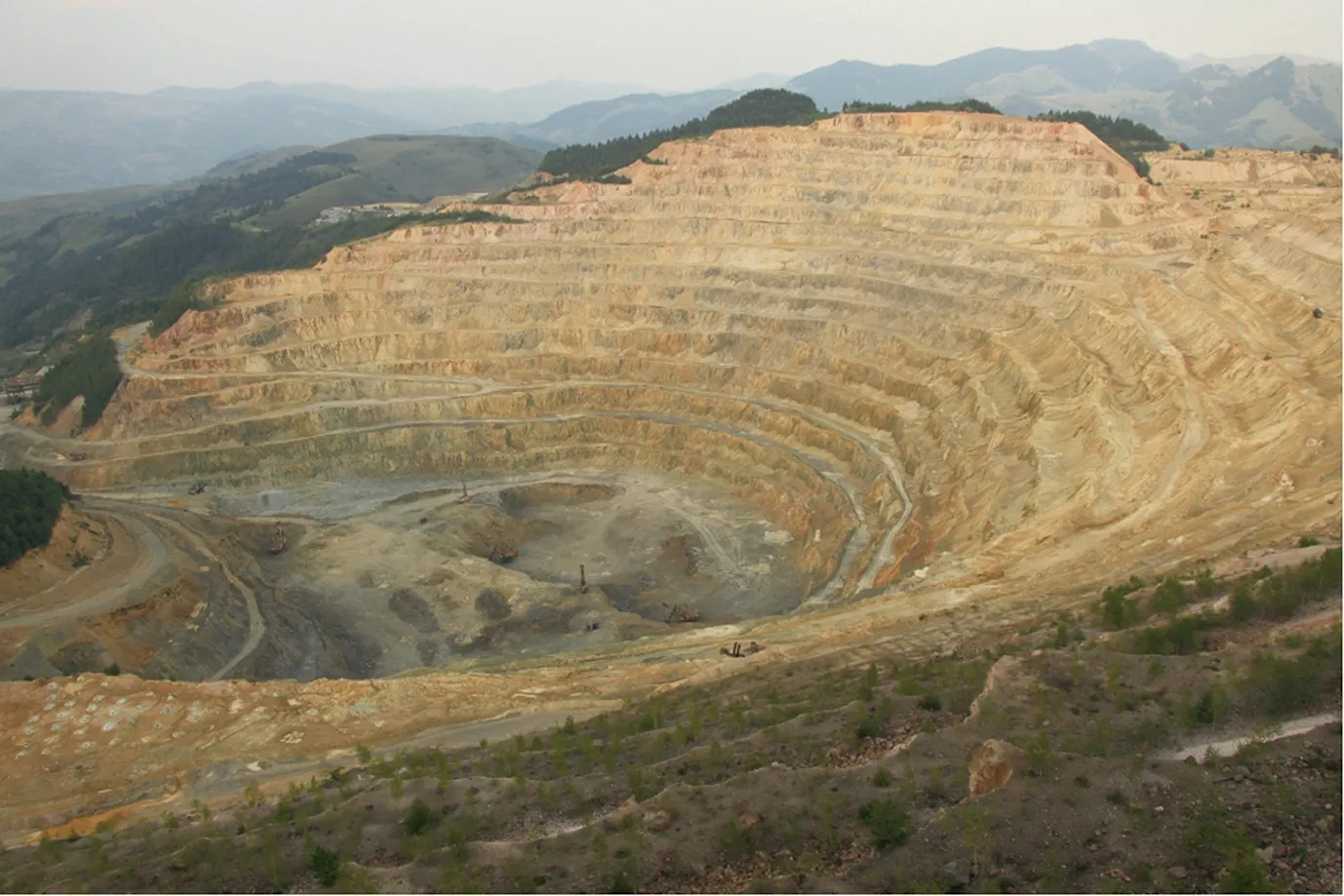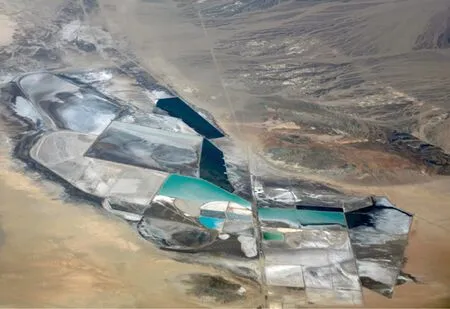Will Massive Appetite for Minerals Stall Clean Energy Transition?
2023-03-22MitchLeslie
Mitch Leslie
Senior Technology Writer
Electric cars purring along the highway differ from nearby internal combustion vehicles not just in their source of power.For parts such as wires and inverters,electric cars require more than twice as much copper as their conventional counterparts[1,2].To keep their batteries generating electricity, they need more than double the amount of manganese [1,3].The average electric car also incorporates an assortment of minerals absent from internal combustion vehicles, including nearly 40 kg of nickel, 13 kg of cobalt, almost 9 kg of lithium, and half a kilogram of rare earth elements such as neodymium, a key component of electric motors [1,4].
Large quantities of minerals go into other climate-friendly technologies,such as solar panels and wind turbines,and demand will soar as the global economy shifts from fossil fuels to renewable energy sources[5].Delivering these materials in time and at a reasonable cost will require vast amounts of new mining and refining,both of which are environmentally destructive.‘‘There is a real fear that we will repeat past mistakes,” said Matthew Eckelman, associate professor of civil and environmental engineering at Northeastern University in Boston, MA, USA.Yet he and other experts hope that a combination of less-harmful mining and refining approaches, recycling, new technologies, sensible government policies, and other steps will limit the environmental damage and protect people who have often borne the brunt of resource extraction’s negative impacts, including workers, residents who live near mines and refining facilities,and Indigenous groups[6,7].
As the world economy weans itself from fossil fuels,production of a variety of materials will have to increase enormously.The World Bank projects that supplies of graphite, lithium, and cobalt—all of which are used in electric vehicles (EVs)—will need to rise 450%by 2050[5].Over the same time,the world will require an additional 90 million tonnes of aluminum as well as an extra 26 million tonnes of copper,a prerequisite not just for EVs but also for the large number of new transmission lines needed to deliver renewable power to users[1,5].The rare earth elements,a category that includes neodymium and praseodymium, are not particularly rare, which is fortunate because their production must increase seven-fold [1].In addition, demand for other construction materials like steel, fiberglass, and concrete will explode [8].
One key question is whether sufficient deposits of critical minerals exist to meet the world’s needs.The consensus from several studies is yes, at least through the middle of the 21st century.In a 2023 analysis, for instance, researcher Seaver Wang of the Breakthrough Institute, an environmental think tank in Berkeley, CA, USA, and colleagues estimated the reserves of 13 key metals, including aluminum, copper, neodymium, and tellurium [8].Only tellurium, they concluded, a component of some types of solar panels,could run short by 2050.However,tellurium is usually a byproduct of copper mining, and its resources are not well-reported, said Simon Jowitt, professor of mining and metallurgical engineering at the University of Nevada, Reno, USA.
New discoveries could increase the reserves.A Swedish company recently uncovered Europe’s largest rare earth deposits [9],for instance, and the US government is performing a nationwide survey to find new resources [10].Moreover, previously untapped mineral sources,such as the manganese-rich nodules on the ocean floor,could boost supplies,although seafloor mining is highly controversial because of its potential environmental cost [11].
Yet ample reserves do not guarantee that these minerals will be available for manufacturing and construction when needed.Moving minerals into the supply chain is a slow process, said Jowitt.‘‘The issue is getting the metal from discovery to production,and that takes 15 years on average.”Roderick Eggert,professor of mineral economics at the Colorado School of Mines in Golden, CO, USA, sees another potential bottleneck.‘‘The constraint is not the quantity of the resource in the Earth’s crust.The constraint is will there be enough investment to develop the deposits,”he said.He worries,for instance,that not enough investment is going into processing and refining of essential minerals, which could lead to shortages.‘‘The biggest risks are in the medium term, 5-20 years into the future,” he said.
Political instability, civil strife, and disputes between countries could also disrupt supply chains.Making the transition to green sources of power is so important that countries ‘‘will have to find a means to cooperate” so that minerals remain available, said Saleem Ali, professor of geography and spatial sciences at the University of Delaware in Newark, DE, USA.
Mining clearly will have to ramp up to meet demand for minerals and metals.But in many countries, new mines face strong opposition from environmental groups, local communities, and other interests.Their campaigns have slowed or halted proposed mines in the United States and elsewhere.For instance,the Boundary Waters area is a pristine wilderness area in the US state of Minnesota—but it is also close to rich nickel and copper deposits [12].Because of the risk of pollution, the US government decided in 2023 to block mining near the wilderness for at least 20 years[13].Ali worries that because of such opposition ‘‘the fossil fuel economy will linger longer than it should.”
At the same time, Ali and other experts emphasize, the mining industry will have to reduce its environmental and social harm[1].‘‘We need materials, and they have to come from somewhere,”Eckelman said.‘‘We need to figure out the least impactful systems of production.”Traditional mining methods can annihilate natural habitats,poison water supplies with acidic runoff,leak radioactive waste, and cause a host of other environmental problems (Fig.1)[14-16].In addition, ‘‘the mining industry has had a fraught history with community relations, particularly with Indigenous peoples,” said Ali.
Mineral processing and refining,which will have to expand over the next few decades, also take a toll on the planet.For example,one approach for refining low-grade nickel ore for use in EV batteries is high-pressure acid leaching, which as the name suggests involves cooking the ore in sulfuric acid at temperatures of around 250°C and pressures of around 5000 kPa[17].In addition to being energy-intensive, the process yields large amounts of corrosive waste, with one refining facility in Indonesia struggling to dispose of the more than four million tonnes of this material it generates every year [18].
The mining industry has tried to improve its practices over the last 20 years or so, Jowitt said.For instance, the members of the International Council of Mining and Metals (London, UK), which includes about one third of companies in the industry,have agreed to abide by standards for limiting pollution, storing tailings, safeguarding human rights, and achieving other goals [19].Investors are also pressuring mining companies to clean up their act [20].
New technologies and approaches could help reduce mining’s impact.For example, the lithium needed for EV batteries comes from rocks, clay, or brine (Fig.2), but the steps for extracting and processing it are environmentally expensive [21].Overall, producing a tonne of lithium requires 60 MW·h of electricity and 70 m3of water [21].Processing can also leave behind acidic material called gangue that is laden with heavy metals as well as other waste,said Andrew Haddad, a research scientist at the Lawrence Berkeley National Laboratory in Berkeley,CA,USA.One alternative approach involves filtering lithium from geothermal water pumped from deep below the surface [22].Several existing geothermal plants near the Salton Sea in southern California, USA, are gearing up to remove the small amounts of lithium found in this water, and other such plants are under construction or planned [22,23].The first is scheduled to start production in 2024, and some estimates suggest that the area could ultimately generate enough lithium to meet the needs of the United States and much of the world [22].This approach is greener because it uses a clean source of power,eliminates the need for mining, and does not require evaporation,which uses large quantities of water and creates waste [22,23].Geothermal lithium extraction could be just the first of many new strategies for curbing the environmental impact of obtaining the huge amounts of the metal needed for batteries and other uses,Haddad said.In 10-20 years, ‘‘I hope we will be getting more lithium from less destructive pathways.”

Fig.1.A prime example of the environmental and social costs of mining,the Roșia Poieni mine in central Romania produces about 11 000 tonnes of copper ore annually.In addition to the clear degradation of the landscape, waste from ore processing starting in the 1970s buried a neighboring village under 90 m of poisonous sludge, forcing most of its residents to leave.Credit: Cristian Bortes (CC BY 2.0).

Fig.2.The Albemarle Corporation lithium operation near Silver Peak, NV, USA,covers more than 5200 hm2 and uses brine pumped from underground to produce lithium carbonate through evaporation.The process takes up to 24 months to complete.Credit: Doc Searls (CC BY 2.0).
Two other key steps can help cut the amount of mining necessary—recycling and reduced use of raw materials through improved efficiency of industrial processes, said Eggert.However, increased recycling of materials such as lithium, cobalt, and manganese faces some obstacles.For one thing, many first-generation EVs and wind turbines that contain these materials are still in service, so the amount available for recycling is relatively small [24].‘‘We cannot get to a circular economy without having a stock built up,” Ali said.
Still, companies are looking to expand their recycling of some metals such as lithium[24].But recycling of other materials is negligible—the rate for rare earth elements like neodymium is only about 1% [25].As Joseph Sarkis, professor of management at Worcester Polytechnic Institute, MA, USA, and colleagues argue in a recent analysis[25],boosting the recycling rate for rare earth elements is possible.However, the effort will require a variety of new measures, including stronger regulations to mandate that companies collect worn-out products for recycling,as well as better tracking procedures.Today, Sarkis said, no mechanism exists for following rare earth elements as they move through the supply chain.And the technology for separating them from other materials once products are ready for recycling needs further development,he added.‘‘A lot of it is in the lab.The question is does it scale up.”
One environmental consequence of transforming the global economy is likely to be smaller than some commenters feared—the quantity of greenhouse gases released by the mining, refining,transportation, and construction needed to make the switch [1,8].In their analysis,Wang and colleagues estimated the total amount of greenhouse gases generated between 2020 and 2050 from suppling industrial metals and raw materials for the green transition,finding that it would probably be less than one-half of what the world,in total,now produces in one year[8].And even their highest estimate for those 30 years was equivalent to only one year’s worth of current greenhouse gas releases [8].‘‘The emissions you would avoid would be dramatically larger than the emissions you would produce,” said Wang.
Experts agree that increased mining, processing, and refining will also have to provide a fair deal to communities where the activities are located.An example is the Voisey’s Bay nickel mine in Canada, which shares a percentage of its royalties with the local Innu and Inuit Indigenous people [26].And the mining industry is ‘‘trying to change by encouraging more high-wage Indigenous employment,”said Ali.‘‘In Australia,the mining industry is the largest private employer of Aboriginal people.”
‘‘There is no silver—or lithium—bullet to solve all of the issues”surrounding the expansion of mining, said Jowitt.Although steps such as increasing recycling and introducing new technologies might reduce the damage,obtaining the minerals for the transition to renewable energy will still take a toll, researchers say.‘‘The question is not will there be enough in the short-to-medium term,”said Eckelman.‘‘The questions will be what is the cost,what is the amount of environmental protection, and what is the effect on mining communities—can they share in the benefits.”
杂志排行
Engineering的其它文章
- Global Top Ten Engineering Achivements 2023
- 2023 Global Engineering Fronts
- Optical Microscopy Advances Reach Sub-Nanometer Resolution
- International Correlation Research Program: Cross-Fault Measurement for Earthquake Prediction
- A Systematic Perspective on Communication Innovations Toward 6G
- Data-Driven Modeling of Maritime Transportation: Key Issues,Challenges, and Solutions
